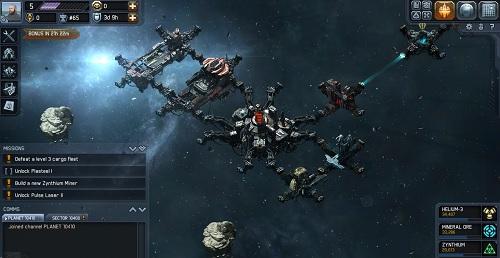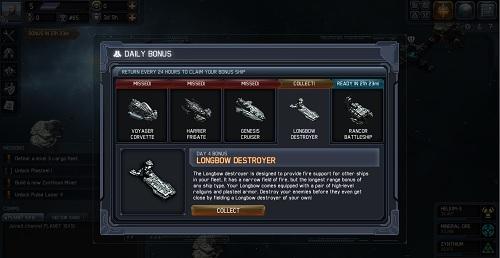- Wondering how to get Monopoly GO! free rolls? Well, you’ve come to the right place. In this guide, we provide you with a bunch of tips and tricks to get some free rolls for the hit new mobile game. We’ll …
Best Roblox Horror Games to Play Right Now – Updated Weekly
By Adele Wilson
Our Best Roblox Horror Games guide features the scariest and most creative experiences to play right now on the platform!The BEST Roblox Games of The Week – Games You Need To Play!
By Sho Roberts
Our feature shares our pick for the Best Roblox Games of the week! With our feature, we guarantee you'll find something new to play!All Grades in Type Soul – Each Race Explained
By Adele Wilson
Our All Grades in Type Soul guide lists every grade in the game for all races, including how to increase your grade quickly!
VEGA Conflict Review
Production values aren’t everything, but all the same, it’s hard not to do a double take when you boot up Vega Conflict and find yourself confronted with a well-voiced and decently animated cutscene. Here, such attention seems to suggest, is a social strategy game for Facebook among the legions of tired clones that’s actually worth playing. For the most part, that’s true. Vega Conflict may tread similar ground as KIXEYE’s previous hit, Battle Pirates, but it handles the transition to space with panache.

Not your typical Facebook confrontation
Production values aren’t everything, but all the same, it’s hard not to do a double take when you boot up Vega Conflict and find yourself confronted with a well-voiced and decently animated cutscene. Here, such attention seems to suggest, is a social strategy game for Facebook among the legions of tired clones that’s actually worth playing. For the most part, that’s true. Vega Conflict may tread similar ground as KIXEYE’s previous hit, Battle Pirates, but it handles the transition to space with panache.
The titular “conflict” of KIXEYE’s latest strategic effort deals with the acquisition of minerals hiding within asteroids, and thus at its heart Vega Conflict isn’t terribly different from the pass of resource-based strategy games already on Facebook. Fortunately, it differs somewhat in the actual process of acquisition. Asteroids float around your platform by the dozens, and you send out teams to secure the safe transmission of minerals back to the camp. But enemies from the Vega Corporation lurk in the darkness, and thus you’ll want to arm these outposts with turrets and similar offensive structures if you don’t want them captured.
A pity, then, that it differs from most of its strategy cousins by letting you extract whatever kind of mineral you want from an asteroid depending on what kind of miners you send to it. The action removes much of the tension (and indeed, actual strategy) involved in the act of expansion, but KIXEYE is experienced enough to spice it up with other elements. You can choose to focus on either defensive or offensive additions for your facilities, for instance, and one of Vega Conflict‘s great strengths is that either approach seems equally promising.
And then, of course, there’s the combat. Mining’s a perfectly honorable and legitimate way to gain resources, but you can achieve even greater gains by hunting down Vega ships in the vicinity and stealing their own resources. The combat takes place in real time, and while it bears a superficial resemblance to some of the space battles you’ll see in a game like EVE Online thanks to the stellar visuals, the actual act of fighting is a simple affair that generally amounts to little more than throwing everything you’ve got at the main enemy. Most battles don’t even take more than a minute, and your ships will only suffer some astronomical repair costs if you lose.
On the bright side, there’s plenty that you can do with those ships. Vega Online includes a rather robust ship modification system that unlocks new upgrades to shields and weaponry as you amass more supplies and build more facilities, although most of it follows the research path toward bigger and better things rather than allowing much leeway for true customization.
Still, there’s a lot of fun to be had here, particularly when you throw other players into the mix and start heading out beyond your local system. All that goodness would be for naught, though, if Vega Conflict had a terrible pricing system, but the truth is that you can play through many of the earliest hours of the game without ever feeling compelled to spend a dime. Naturally, build and collection times grow longer as you level, but the option to spend premium currency always seems to exist as a mere convenience, rather than a necessity.
Much like Battle Pirates, Vega Conflict spices up the well-worn resource management template on Facebook with real-time battles and memorable visuals to create a somewhat unique experience. It’s a robust and enjoyable strategy experience for its medium, even to the point that it occasionally seems like the blueprint for a larger project.

The good

The bad
More articles...
Monopoly GO! Free Rolls – Links For Free Dice
By Glen Fox
Wondering how to get Monopoly GO! free rolls? Well, you’ve come to the right place. In this guide, we provide you with a bunch of tips and tricks to get some free rolls for the hit new mobile game. We’ll …Best Roblox Horror Games to Play Right Now – Updated Weekly
By Adele Wilson
Our Best Roblox Horror Games guide features the scariest and most creative experiences to play right now on the platform!The BEST Roblox Games of The Week – Games You Need To Play!
By Sho Roberts
Our feature shares our pick for the Best Roblox Games of the week! With our feature, we guarantee you'll find something new to play!All Grades in Type Soul – Each Race Explained
By Adele Wilson
Our All Grades in Type Soul guide lists every grade in the game for all races, including how to increase your grade quickly!








 “
“